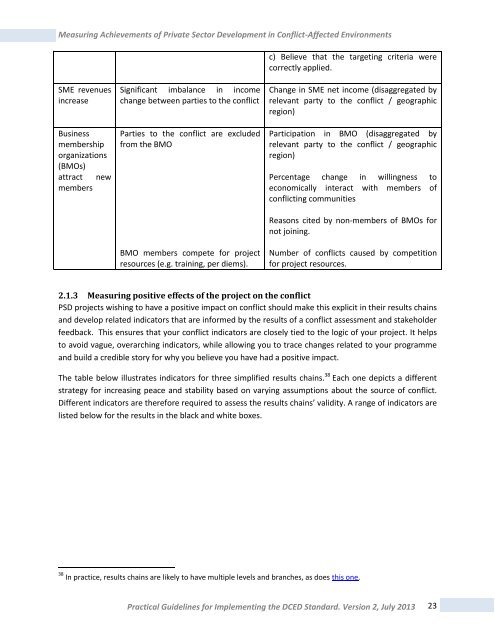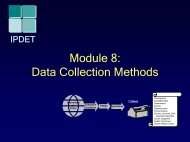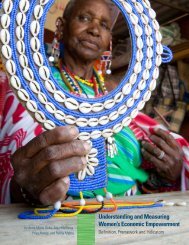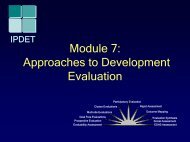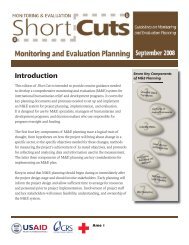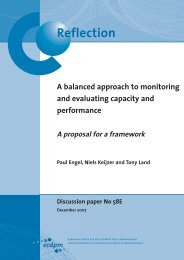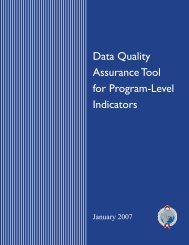Measuring Achievements of Private Sector Development in ... - DCED
Measuring Achievements of Private Sector Development in ... - DCED
Measuring Achievements of Private Sector Development in ... - DCED
Create successful ePaper yourself
Turn your PDF publications into a flip-book with our unique Google optimized e-Paper software.
<strong>Measur<strong>in</strong>g</strong> <strong>Achievements</strong> <strong>of</strong> <strong>Private</strong> <strong>Sector</strong> <strong>Development</strong> <strong>in</strong> Conflict-Affected Environments<br />
c) Believe that the target<strong>in</strong>g criteria were<br />
correctly applied.<br />
SME revenues<br />
<strong>in</strong>crease<br />
Bus<strong>in</strong>ess<br />
membership<br />
organizations<br />
(BMOs)<br />
attract new<br />
members<br />
Significant imbalance <strong>in</strong> <strong>in</strong>come<br />
change between parties to the conflict<br />
Parties to the conflict are excluded<br />
from the BMO<br />
BMO members compete for project<br />
resources (e.g. tra<strong>in</strong><strong>in</strong>g, per diems).<br />
Change <strong>in</strong> SME net <strong>in</strong>come (disaggregated by<br />
relevant party to the conflict / geographic<br />
region)<br />
Participation <strong>in</strong> BMO (disaggregated by<br />
relevant party to the conflict / geographic<br />
region)<br />
Percentage change <strong>in</strong> will<strong>in</strong>gness to<br />
economically <strong>in</strong>teract with members <strong>of</strong><br />
conflict<strong>in</strong>g communities<br />
Reasons cited by non-members <strong>of</strong> BMOs for<br />
not jo<strong>in</strong><strong>in</strong>g.<br />
Number <strong>of</strong> conflicts caused by competition<br />
for project resources.<br />
2.1.3 <strong>Measur<strong>in</strong>g</strong> positive effects <strong>of</strong> the project on the conflict<br />
PSD projects wish<strong>in</strong>g to have a positive impact on conflict should make this explicit <strong>in</strong> their results cha<strong>in</strong>s<br />
and develop related <strong>in</strong>dicators that are <strong>in</strong>formed by the results <strong>of</strong> a conflict assessment and stakeholder<br />
feedback. This ensures that your conflict <strong>in</strong>dicators are closely tied to the logic <strong>of</strong> your project. It helps<br />
to avoid vague, overarch<strong>in</strong>g <strong>in</strong>dicators, while allow<strong>in</strong>g you to trace changes related to your programme<br />
and build a credible story for why you believe you have had a positive impact.<br />
The table below illustrates <strong>in</strong>dicators for three simplified results cha<strong>in</strong>s. 38 Each one depicts a different<br />
strategy for <strong>in</strong>creas<strong>in</strong>g peace and stability based on vary<strong>in</strong>g assumptions about the source <strong>of</strong> conflict.<br />
Different <strong>in</strong>dicators are therefore required to assess the results cha<strong>in</strong>s’ validity. A range <strong>of</strong> <strong>in</strong>dicators are<br />
listed below for the results <strong>in</strong> the black and white boxes.<br />
38 In practice, results cha<strong>in</strong>s are likely to have multiple levels and branches, as does this one.<br />
Practical Guidel<strong>in</strong>es for Implement<strong>in</strong>g the <strong>DCED</strong> Standard. Version 2, July 2013<br />
23


